Welcome to the definitive look at Inflexion Games’ new early access title, Nightingale, in which I discuss all the things your favorite reviewer has never mentioned*. I’m not alone when I say that this Victorian, steampunk, crafting/survival game set in the Fae Wilds has dominated my free time. And I’m certainly not alone in crossing the 200 hour mark, joining the ranks of many players who have long since run out of story content while awaiting major content updates from the devs.
That’s not what we’re here to discuss today, though. We’re not going over the basics of turning your first sticks and stones into an axe, the first of many tools on your way to crafting fancy metal tools and stylish threads. Or, indeed, guns. I’m going to bypass these basic gameplay elements (which are already in abundance on the internet if you’re looking for them) in favor of some less talked about aspects of the game. The “why,” if you will, of playing Nightingale over any of the other wonderful titles in the crafting/survival genre.
And with that, let’s pop our umbrella glider and sail right in!
*Note: Unless we’re your favorite reviewers. We’re not sure how you came to find us in such high regard, but we thank you all the same!
Into The Light
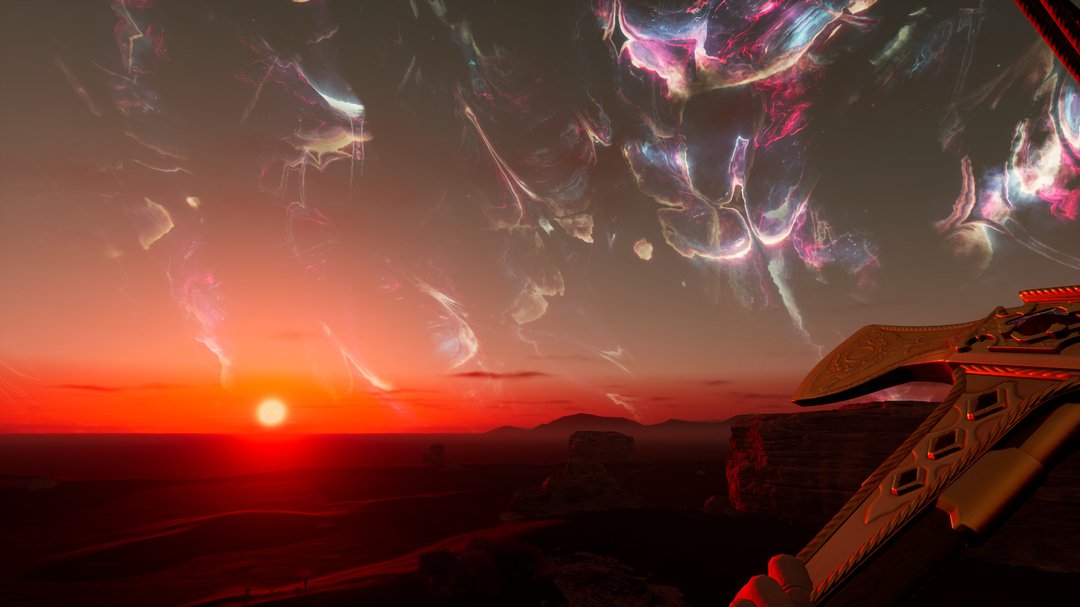
For the pictures in this feature, please enjoy a variety of incredible skies. This game has no shortage of them!
It was my first time playing multiplayer with friends. We’d all agreed to meet at Wyatt’s home base, a sturdy stone cabin with a six-floor tower, smack in the middle of his swamp. There was time to kill as he finished crafting a few things prior to setting out together, and as I waited for him to finish, the sun began setting over the treetops. Sunsets in this game are breathtaking. I never tire of seeing them, much like sunsets in real life. It was then that Wyatt suggested we come up to the top of the tower to view the sun slipping beyond the horizon.
I climbed the steps, not expecting much besides a more expansive view, but this was the start of my realization of how wrong I was. When I reached the top of the tower, I was shocked to find that the game was modeling the light levels differently. Twilight was setting in, and on ground level where I’d been moments before it was nearly dark. From the tower, however, I could still make out the faint blue of the horizon and the linger light still hanging above the trees. I’d be lying if I said my jaw didn’t drop just a little then and there. One world, one sunset. Two completely different views of twilight. One below the trees, one above them.
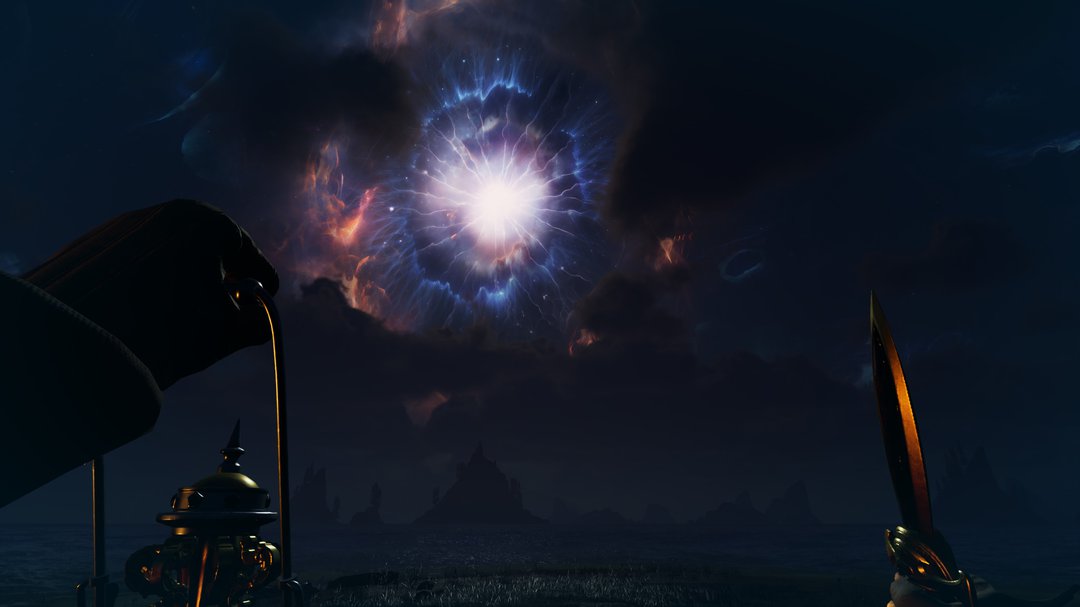
I later confirmed this phenomenon on my own, quite by accident. As the memory of this one subtle, spectacular moment faded into the gameplay, replaced by resources and crafting, slaying monsters, all the more typical genre fare, I found myself working on some estate renovations in my own home realm. The sun had just risen, and as I laid out fresh stonework on my manor’s upper level, I paused to watch the shadows migrate across a wall. This in itself wasn’t anything particularly noteworthy. Plenty of other games have moving shadows. It was the wall itself that caught my attention.
Had the light on wall just dimmed slightly, or were my eyes just tired from hours of play? I ignored the shadows and focused harder on the wall. I waited. It brightened by the most imperceptible of degrees. I spun back around, looking straight up towards the sun to catch a glimpse of a cloud moving past it. Had the clouds actually affected the sun’s ambient light level in the world? Were they more than just a visual layer stretched over a skybox? I waited for the next approaching cloud to reach the edge of the sun and spun to face the wall again. I stared. The wall darkened, then darkened a little more as this thicker cloud made its passage.
To Be Or Not To Be
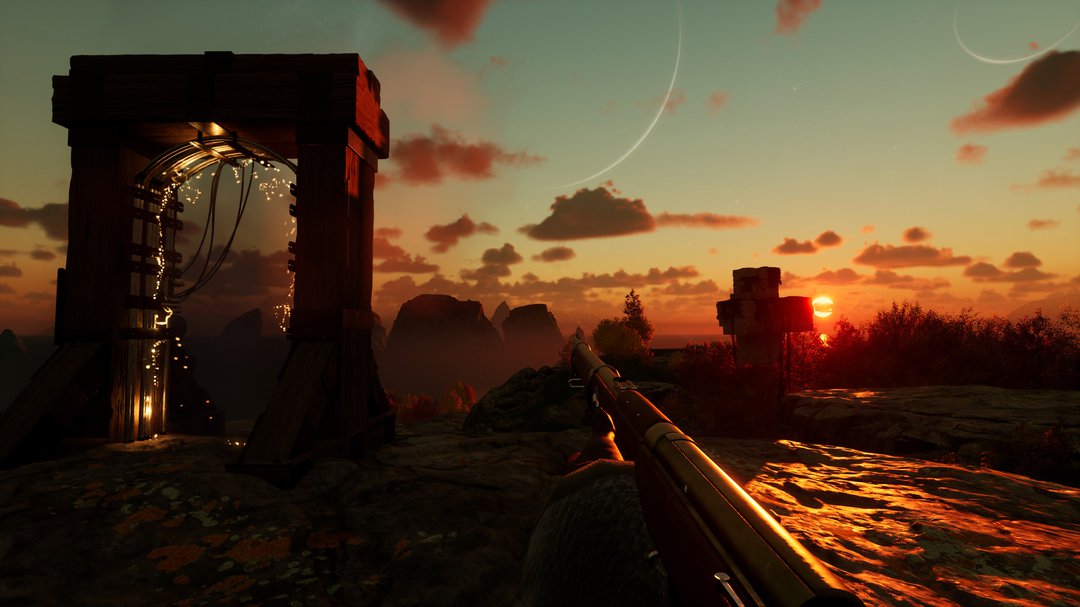
I know what you’re thinking. It’s all well and good to marvel at this obscure little detail, something that will ultimately have no influence over actual gameplay and mechanics. It won’t make or break your harvesting expeditions. It’s not going to change the course of the story. Probably 95% of players haven’t even noticed this level of depth in the game. So why am I so obsessed about it?
Because it exists.
In a conversation I had with Wyatt about similar games, one of the things I heard him lament was how the immersion of many games fades the more you play them. You’ll start with a thematic intro, an evocative tutorial, but soon enough you’re just watching numbers pop over the heads of your enemies. Zones are no longer neighborhoods or worlds to be explored but levels to be cleared. You start referencing “bosses” and “dungeons” and “levels” and using the same abbreviated gamer-speak with your friends as every other game you play together. If lore exists, it exists as a thing within a game, not as the game itself.
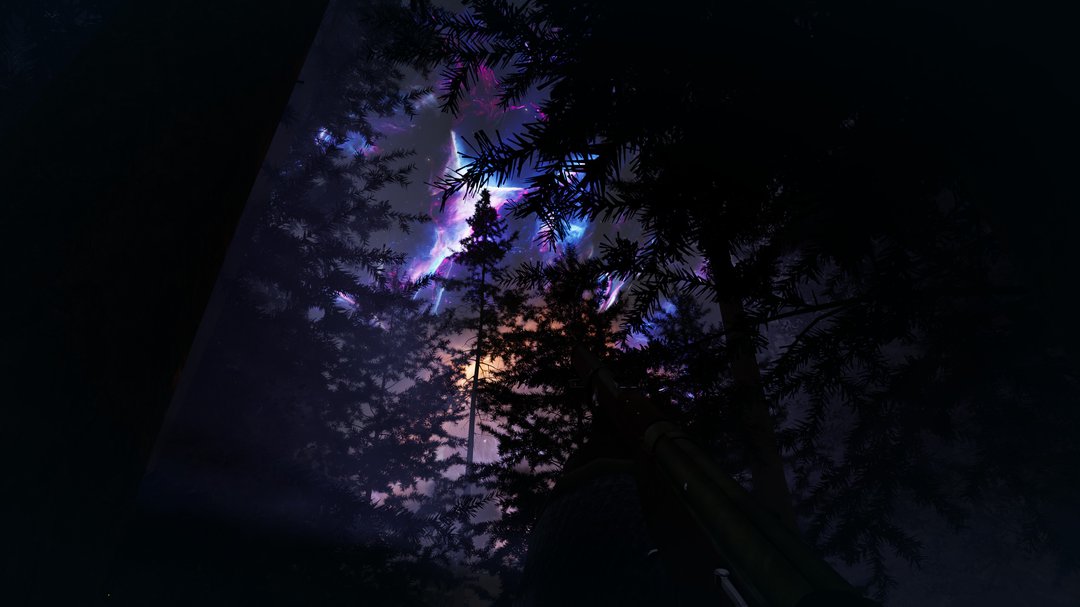
The separation of a game and its lore is a point I agree happens. I’m guilty of doing this myself, boiling games down until I’m stuck in their gameplay loop devoid of any thematic enjoyment. The funny thing is, I think Nightingale defies this kind of play. At no point adventuring alone or together did we start referring to creatures in a removed-from-their-lore sense. We’d call enemies by their proper names. If we found something unknown, we’d immediately begin cross-referencing what it could be with our existing lore knowledge, attempting to make sense of our new discoveries with in-game logic.
Some people online have already decried Nightingale because it’s not more like their favorite survival/crafting game. It’s doesn’t have the same gameplay as Ark. It doesn’t have as much narrative driving the action as Subnautica. And I agree. That’s why I love it. Whether you’re playing Nightingale for its aesthetic, because you love the genre, or because you just happened upon it, it’s not interested in appeasing your desire to be like other games. It’s going to march to its own beat, and if you accept it for what it is, you may find that you experience something fresh. Something you may have never actually experienced in a game before. Or perhaps something nostalgic that you remember from an older time, thought lost in the world of modern games.
The Lore Of The Lands
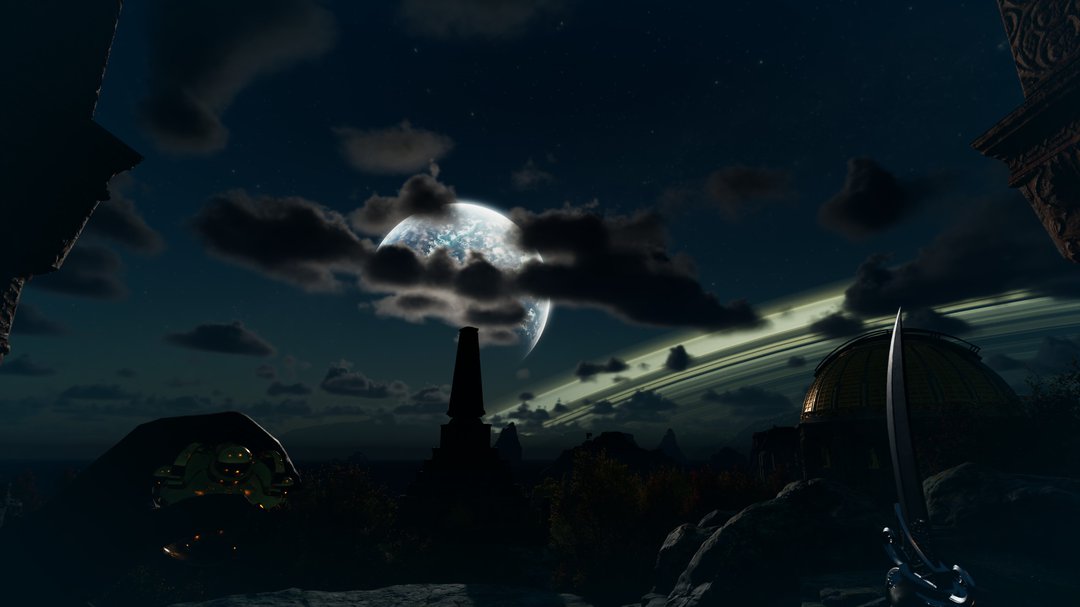
I am crouched in the bushes, aiming my new bolt-action rifle at my prey. I’m on the hunt for food, and one good shot should take down my quarry, a deer-like creature off in the clearing ahead. I aim for the head. The shot is not fatal, and the creature disappears into the forest. Nightingale, without any tutorials or tooltips, is teaching me to unlearn much of the video game logic I’ve picked up over the years. Just as with a real-life hunt, I should be aiming for the heart, to the chest of the deer and slightly to one side. Positioning is key, as is aim. And I find the rediscovery, frustrating only at first, to be refreshing.
I am something of an amateur naturalist in real life, and Nightingale rewards me for thinking like one. I find, after hours of Nightingale, and reflecting on my own gameplay, that if you accept the game’s presentation and pace, you are made to feel observant, clever, as if you are actually learning to survive in the hostile Fae Wilds.

Again, these might be minor gameplay elements, but in the context of the larger picture they have all contributed to my greater enjoyment of Nightingale. I’ve noticed things like grasses growing in swampy shallows, denoting safe paths for walking (avoiding the disease status that triggers if you spend too long in deep water). At first it was frustrating trying to figure out where higher tier wood spawned until I realized how to spot them by type and color in larger forests. I used to avoid certain hostile looking creatures until I saw them coexisting one day with obvious prey animals. It was then I realized they were actually herbivores and not dangerous at all! Some advanced materials grow in peculiar formations, much more easily scouted from a high vantage point if you know what you’re looking for.
At every turn Nightingale rewards you for learning about its realms. If we return to the actual gameplay selling points, you discover during play that multiple materials can be blended in crafting to yield unique visual results and stat boosts. That the realms themselves can be customized by using combination of cards, it feels only natural that we should enjoy learning about all the realms have to offer. Early on this takes the form of the most efficient way to find and harvest larger quantities of rare resources, but later on you’ll be saving specific realms for special purposes, perhaps establishing a rainy farm realm or magically enhanced ammo and tool crafting outpost. Never before in my memory has a game so seamlessly taken the idea of the crafting grind and made it feel like a natural part of shaping its game worlds.
No Place Like Home
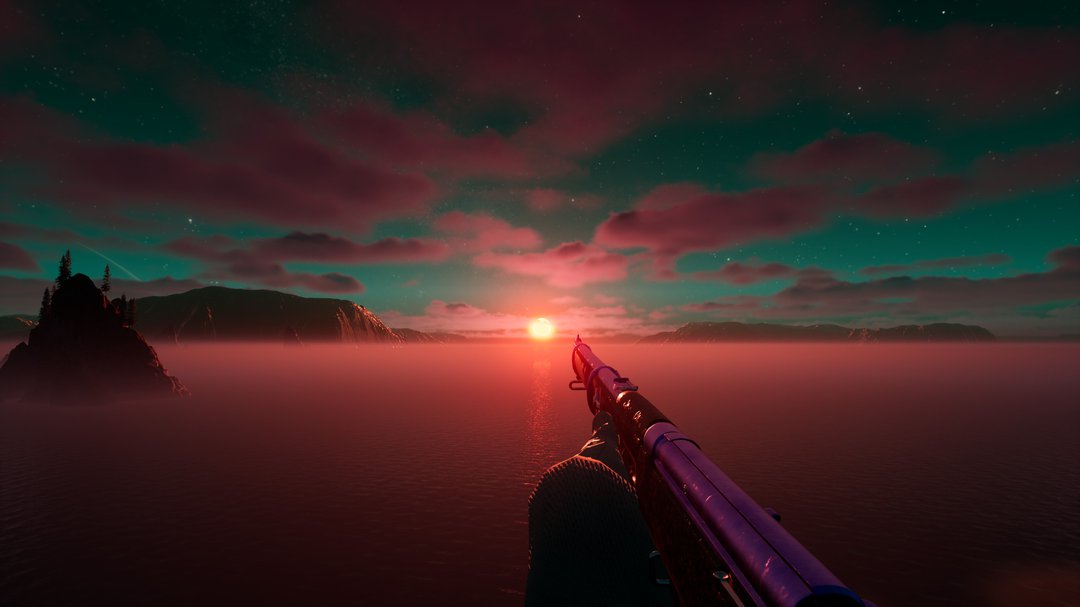
Nightingale is, of course, still early access. There is optimization that needs to be done, especially in multiplayer. The housing construction limits currently cut short grandiose plans of palatial estates. And the story is engaging but quickly expended, leaving us all hungry for the next chapters, pushing on towards the game’s namesake, arguably the longest wait of the content patches. All these things are being addressed by the devs, who have remained remarkably transparent on the items in their work backlogs (both short and longer term). They’ve also set a pace of regular updates that keep adding brand new twists to exploration. They’ve proven they’re open to feedback from the community while also staying true to their own vision for their game.
All of this bodes very well for the future of this game, shining brightly like the colors dancing across the night skies of the Fae Wilds. For me, though, perhaps the most enticing promise is one that lies not in what I haven’t yet seen, in the expectation of new content releases, but what I have already experienced. The bare bones beauty of this game, a cloud-darkened plaster wall, in all the myriad forms the game environments, the largest character in the game after Puck, reveal to me. Look and you will find. Take a moment to stop and appreciate the sunset. Feel the ebb and flow of life in these realms. Perhaps of all the crafting/survival games out there today, you belong in the Fae Wilds after all.